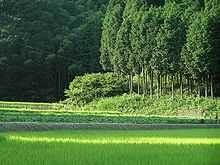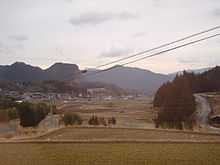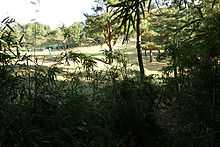Satoyama
- For the sumo wrestler Satoyama, see Satoyama Kosaku


Satoyama (里山) is a Japanese term applied to the border zone or area between mountain foothills and arable flat land. Literally, sato (里) means arable and livable land or home land, and yama (山) means hill or mountain. Satoyama have been developed through centuries of small scale agricultural and forestry use.
The concept of satoyama has several definitions. The first definition is the management of forests through local agricultural communities. During the Edo era, young and fallen leaves were gathered from community forests to use as fertilizer in wet rice paddy fields. Villagers also used wood for construction, cooking and heating. More recently, satoyama has been defined not only as mixed community forests, but also as entire landscapes that are used for agriculture. According to this definition, satoyama contains a mosaic of mixed forests, rice paddy fields, dry rice fields, grasslands, streams, ponds, and reservoirs for irrigation. Farmers use the grasslands to feed horses and cattle. Streams, ponds, and reservoirs play an important role in adjusting water levels of paddy fields and farming fish as a food source.[1]
Population, ownership, and land use

Population decline in villages has been a significant driving factor in the disappearance of satoyama from the Japanese landscape. Economic growth from 1955 to 1975 created significant social and economic gaps between cities and villages and led to the depopulation of mountain villages, where life was made difficult by natural conditions such as steep slopes, landslides, and snowfall. Ownership patterns have also been a factor. Shared ownership of satoyama forests near villages has been common since the beginning of 19th century. These forests were logged for economic considerations and the construction of houses. Because forests near villages have been cut down, old-growth forests today (including beech forests at high elevations) are often located far from villages. Inhabitants use wood from their private forests and conifer plantations for fuel. By the 1960s, satoyama were utilized as rice fields, plowed fields, shifting cultivation, grasslands, thatch fields, secondary forests for fuel, and giant bamboo forests.[2]
Biodiversity

Various habitat types for wildlife have been provided by mixed satoyama landscape as a result of Japanese traditional agricultural system that also facilitates the movement of wildlife between a variety of habitats. The migration of wild animals can occur between ponds, rice paddies, grasslands, forests, and also from one village to another. Ponds, reservoirs, and streams in particular play a significant role in the survival of water dependent species such as dragonflies, and fireflies. In the early stages of their life cycle, they spend most of their time in water. Deciduous oaks such as Quercus acutissima and Quercus serrata are planted by farmers to maintain deciduous broad-leaf trees.[3] Succession to dense and dark laurel forest is prevented by farmers that cut down these trees for firewood and charcoal every 15 to 20 years. Many plant and animal species are able to live in these deciduous forests because of traditional management practices.
Causalities of the disappearance

Satoyama have been disappearing due to the drastic shift in natural resources from charcoal and firewood to oil and the change from compost to chemical fertilizer. Also, the problem of aging in Japanese society can cause the disappearance of satoyama because there are fewer people who can work in satoyama which are considered as intermediate disturbance on forests such as harvesting trees for timber and charcoal, cutting shrubs for firewood and collecting litter as compost. These human impacts can help the success of the forest occur. As the final causality of the disappearing of satoyama, pine dominated secondary forests in satoyama were increasingly destroyed since pine wilt disease devastated pine forests in the 1970s.[4][5]
Conservation
Throughout the 80s and 90s, the satoyama conservation movement was implemented in Japan. As of 2001, there are more than 500 environmental groups that work for the conservation of satoyama. Because of their efforts, satoyama has become more prevalent in Japanese landscapes.[6]
In popular culture
The satoyama of Saitama Prefecture have been illustrated in anime with great precision and artistic attention to detail in the very popular film, My Neighbor Totoro, by Studio Ghibli, under the direction of the studio's head and founder, Hayao Miyazaki. The prominence of the satoyama as environment for the story has stirred popular interest in the regions, and encouraged conservation efforts in recent times, in large part thanks to this film. See section Totoro.
David Attenborough also narrated a one-hour program called Satoyama for NHK in 2004.
The Japanese idol company Hello! Project Launched a new show called Hello! SATOYAMA Life. Hello! SATOYAMA Life is a TV show showcasing the members of Hello! Project, including Morning Musume, Berryz Koubou, ℃-ute, Mano Erina, S/mileage, and Mitsui Aika. Unlike Hello! Pro TIME, Hello! SATOYAMA Life is based on agriculture and nature. Different girls are selected to take a camera around and film various topics about agriculture and nature. The show is aired on TV Tokyo.
See also
- Beneficial insects
- Biodiversity banking
- Companion planting
- Convention on Biological Diversity
- Deforestation
- Insect—Relationship to humans
- Land use, land-use change and forestry
- Laurel forest
- Masanobu Fukuoka
- My Neighbor Totoro, anime film set in the Satoyama of Saitama prefecture, by Studio Ghibli
- Natural landscape
- Paddy field
- Temperate deciduous forest
- Terrace (agriculture)
- Vermin
- Wildlife corridor
- Wildlife management
References
- ↑ Hiromi Kobori; Richard B. Primack (June 2003). "Participatory Conservation Approaches for Satoyama, the Traditional Forest and Agricultural Landscape of Japan". AMBIO: A Journal of the Human Environment. Sweden: Royal Swedish Academy of Sciences. pp. Article: pp. 307–311. Archived from the original on 2008-10-09.
- ↑ Fukamachi Katsue, Oku Hirokazu, and Nakashizuka Tohru (2001) The change of a satoyama landscape and its causality in Kamiseyama, Kyoto Prefecture, Japan between 1970 and 1995. Landscape Ecology 16: 703-71
- ↑ Takeuchi, Kazuhiko, and R. D. Brown (2003). Satoyama: The Traditional Rural Landscape of Japan. Springer-Verlag Tokyo. p. 53
- ↑ Morimoto Junko and Yoshida Hironobu (2003) Dynamic changes of native Rhododendron colonies in the urban fringe of Kyoto city in Japan: detecting the long-term dynamism for conservation of secondary nature. Landscape and Urban Planning 70: 195–204
- ↑ Satoyama. Takeuchi K, Brown R.D., Washitani I., Tsunekawa A., Yokohari M. (2003) The traditional rural landscape of Japan. Landscape and Urban Planning. 229 pp., ISBN 4-431-00007-0
- ↑ Takeuchi Kazuhiko, Wahitani Izumi and Tsunekawa Atsushi (2001). Satoyama: The Traditional Rural Landscape of Japan. University Tokyo Press 133–135 ISBN 4-13-060301-9
Further reading
- Takeuchi, K. & Brown, R.D. & Washitani, I. & Tsunekawa, A. & Yokohari, M., 2008. Satoyama: The Traditional Rural Landscape of Japan Second Edition, Springer. ISBN 4-431-00007-0, ISBN 978-4-431-00007-5. A comprehensive commentary book of Satoyama, including the conservation.
External links
- Satoyama Initiative Official Portal Site, Ministry of the Environment of Japan, the United Nations University Institute of Advanced Studies
- Participatory Conservation Approaches for Satoyama, the Traditional Forest and Agricultural Landscape of Japan, AMBIO: A Journal of the Human Environment; The Royal Swedish Academy of Sciences
- SATOYAMA Gallery Pictures of satoyama
- NOVA online: Japan's Secret Garden, Public Broadcasting Service
- Human Well–Being and the Restoration of Satoyama, United Nations University
- Wildlife in satoyama; The Village Forest Environmental Biology Laboratory (里山と雑木林の生きものたち;里山環境生物学研究所)(In Japanese)
- In the Pines A blog offering an anthropological perspective of satoyama life in Nagano, Japan
- Satoyama in the world through NHK web site (In Japanese with photo gallery)
- 世界里山紀行、フィンランド 森・妖精との対話;(World satoyama travel in Finland, Literally; Forest - Dialog with fairy), NHK
- 世界里山紀行、ポーランド 水辺に響きあういのち;(World satoyama travel in Poland, Literally; The lives echoing around waterside), NHK
- 世界里山紀行、中国・雲南、竹とともに生きる;(World satoyama travel in Yunnan, China, Literally; Symbiotic human life with bamboo), NHK
- Satoyama videos produced by the United Nations University (on YouTube)
- Harvest time in Satoyama and associated article on Our World 2.0 Harvet time in Satoyama
- Life in a vibrant satoyama forest and associated article on Our World 2.0 Greetings from Satoyama